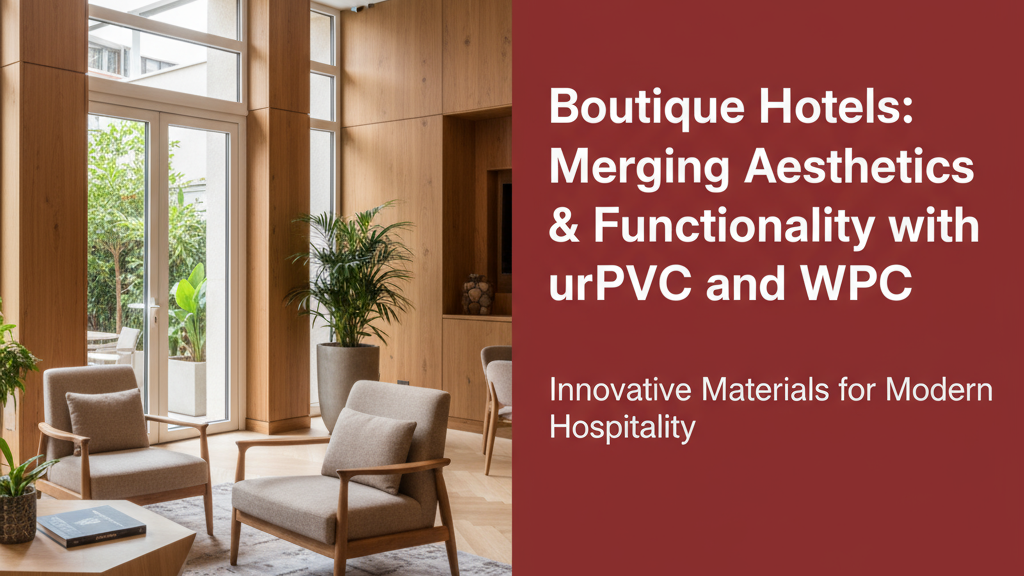The Rise of Boutique Hotels
Boutique hotels have redefined hospitality by offering intimate stays with personalised experiences. Unlike conventional hotels, these establishments prioritise unique design narratives that reflect local culture or thematic concepts. As Indian travellers increasingly seek distinctive accommodations, architects and designers face the challenge of merging aesthetics with practical durability—particularly given India’s climate conditions of high humidity, monsoon rains, and urban pollution.
Why Aesthetics Matter in Boutique Hotels
First impressions in boutique hotels hinge on visually cohesive interiors that tell a story. From lobby ceilings to bathroom fittings, every element contributes to an immersive ambiance. However, visual appeal alone isn’t enough; materials must withstand heavy foot traffic, frequent cleaning, and moisture exposure without fading or warping.
The Role of Functionality in Hotel Design
Behind the scenes, hotels demand materials that are:
- Low-maintenance: Resistant to scratches, stains, and fungal growth.
- Acoustically efficient: Minimising noise transfer between rooms.
- Thermally stable: Reducing HVAC loads in tropical climates.
Traditional materials like wood or plaster often fall short, requiring constant upkeep. Modern alternatives like uPVC and WPC (Wood-Plastic Composite) bridge this gap effectively.
uPVC: The Perfect Blend of Style and Durability
Unplasticised Polyvinyl Chloride (uPVC) has become a staple for windows, doors, and even decorative wall panels in boutique hotels. Its engineered properties include:
- Weather resistance: Withstands temperatures from -30°C to 60°C without warping.
- Customisability: Available in wood-grain finishes or matte colours matching hotel themes.
- Noise reduction: Multi-chamber uPVC frames can reduce external noise by 25–40 dB.
WPC: Sustainable Elegance for Modern Hotels
Wood-Plastic Composites (WPC) mimic natural wood textures while offering superior functionality. Made from recycled wood fibres and thermoplastics, WPC suits areas where authenticity meets heavy usage:
- Decking and terraces: Resists splintering and moisture damage unlike timber.
- Wall cladding: Provides insulation (thermal conductivity: 0.1–0.2 W/mK) without sealing treatments.
- Ceiling panels: Lightweight yet durable, with fire-retardant options available.
Benefits of uPVC in Boutique Hotels
uPVC’s adaptability shines in hospitality settings:
| Application | Advantage |
|---|---|
| French windows | Maintains insulation with airtight gaskets |
| Bathroom partitions | Impervious to humidity and chemical cleaners |
| Lobby doorways | Robust frames support heavy usage (tested for 10,000+ cycles) |
Unlike aluminium, uPVC doesn’t conduct heat, reducing condensation issues in air-conditioned spaces.
Advantages of WPC for Hotel Interiors
WPC’s hybrid composition delivers:
- Sustainability: Contains 50–70% recycled content, aligning with eco-conscious branding.
- Design flexibility: Can be milled into intricate mouldings or curved surfaces.
- Hygiene: Non-porous surface inhibits bacterial growth, ideal for spas or kitchens.
A Kochi heritage-themed hotel used WPC for its antique-effect wall panels, achieving vintage charm without wood’s susceptibility to termites.
Case Studies: Boutique Hotels Excelling with uPVC and WPC
1. Mountain Resort (Darjeeling): Installed uPVC windows with triple glazing to combat chilly winds while maintaining panoramic views. Energy savings reached 18% due to reduced heat loss.
2. Goa Beachside Villa: WPC decking resisted saltwater corrosion and required only annual cleaning, unlike traditional teak that needed quarterly varnishing.
Future Trends: uPVC and WPC in Hospitality Design
Emerging innovations include:
- Textured uPVC: Embossed finishes mimicking concrete or linen for industrial-chic interiors.
- Integrated WPC systems: Pre-fabricated bathroom pods with built-in WPC walls for faster installation.
- Smart-material hybrids: uPVC frames with embedded sensors for automated climate control.
Conclusion: Crafting the Ideal Boutique Experience
Materials like uPVC and WPC empower designers to push creative boundaries without compromising on practicality. For boutique hotels, this means delivering visually captivating spaces that remain functional through monsoons, summers, and years of guest turnover—proving that good design needn’t sacrifice durability.


